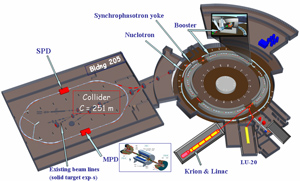 |
 |
|||||||||||||
|
|||||||||||||
|
|||||||||||||
|
This week marks the beginning of a small series in ILC NewsLine on future projects in particle physics beyond the linear collider. Today's Director's Corner summarises the talks on future projects from the recent International conference on High Energy Physics. This article gives a small inventory of ideas that are being discussed. Selected projects will then be presented in more detail in future issues, to highlight new accelerator concepts, technology and challenges for the possible future projects. They fall into several different categories. Most immediate are projects that in some way build on or complement the Large Hadron Collider (LHC). Another category are projects that deal with neutrino or flavour physics. And there are ion colliders and projects that look at new ways of acceleration to make accelerators shorter and thus less costly. None of them have officially been accepted, and like all plans for the future these concepts are evolving. They may never be built, or be built in different ways described here — but that is the nature of the field. The first category is not only the most immediate, but also the biggest. It needs further splitting into two subcategories: projects that study LHC discoveries in more detail, and ideas for the future of the LHC itself. Obviously, the ILC and CLIC fall into the first subcategory and do not need further introduction here. LHC results will determine which of these gets built, and while it may seem strange to have the next machine ready when those results haven't even been produced, when you think that first collisions from a linear collider could be expected in the 2020s you start to understand why there is already plenty of planning, designing and testing going on around the world. Muon colliders also fall into this category — with higher energies they could also do exciting precision studies at high energies in a relatively small and thus cheaper ring. A number of R&D projects are underway to tackle the challenges that accelerating muons bring.
Subcategory two – the future of the LHC itself – is a wide field. Two different varieties of LHC upgrades exist – one for more luminosity and thus higher statistics and safer discoveries, one for higher energies. Whereas one, the luminosity upgrade, is virtually around the corner, the energy upgrade is an option that's far in the future (around 2030, according to Roger Bailey's talk at ICHEP). The LHC could also be transformed into an electron-proton machine, or a 'superHERA', or LHeC, with the e for electron. LHeC would collide the LHC's protons with electrons from either a linear collider, or a linear collider driven by an energy-recovery linac, or from a separate electron ring. Its aim is to do measurements on precision QCD, electroweak physics, physics beyond the Standard Model and more. Then there are B factories, machines that would complement and extend anything that the B physics experiments around the world, like the LHCb experiment at the LHC, find. One is proposed in Italy, and KEK in Japan has just started reconfiguring its KEKB accelerator into SuperKEKB. Funding is half way there, and they are planning to get 40 times more luminosity – certainly one of the future projects that is almost a current project already. The Italian B factory would also be a light source, and it shares this aspect of multifunctionality with Fermilab's 'Project X', an accelerator R&D project that can contribute to the ILC, to a muon collider and ultimately a possible neutrino factory. Category three, ion colliders, pick up the question of the quark gluon soup where RHIC and ALICE at the LHC have left them. There are plans for a follow-up to RHIC, aptly named RHIC-II, or to turn the LHC into an Large Hadron Ion Ring, but much further advanced are plans for a heavy ion collider in Dubna, called NICA, which complements the FAIR facility under construction in Germany. The challenges that some of the ideas bring — how to keep muons stable for long enough to get them to collide, for example, or how to power an electron beam with the wakefield of another one, make up the fourth category. Fermilab is busy working on a plan for a muon accelerator program (i.e. a MAP), and muon colliders, though technologically still a big challenge, are also a big topic for machine physicists. A whole range of projects exists that try to loosen the technological grip on things like plasma wakefield or dielectric acceleration, and we invite people working on these challenges to contact us so that we can introduce them in more detail. Particle physics is global and most of the future machines will be built by global collaborations rather than one country or one laboratory alone. The more challenging the technologies become the more this is the case, and it also takes many years for a machine to evolve from idea to design study to running accelerator. Consequently it may seem strange to the outside world that while we've only just switched on the LHC and are waiting for discoveries, we already plan the next generation — but we have to have a variety of options in the drawer that will enable us to make the best choice when results are there. Stay tuned for the detailed reports! -- Barbara Warmbein |
|||||||||||||
| © International Linear Collider |
